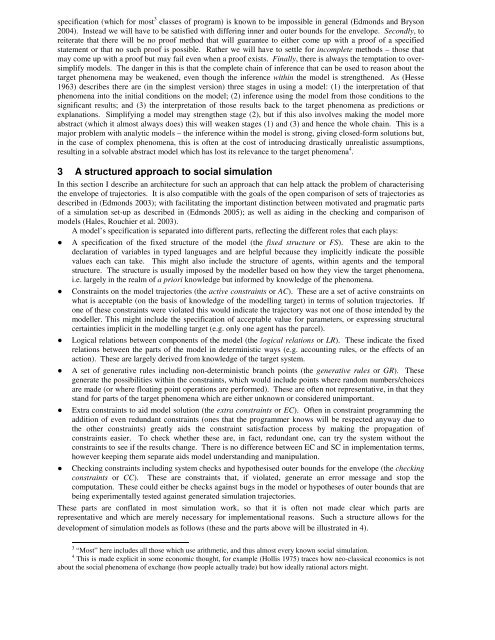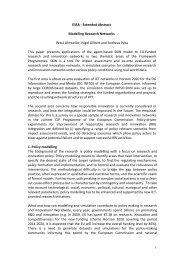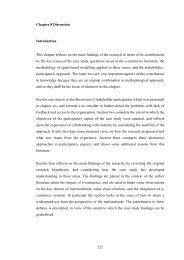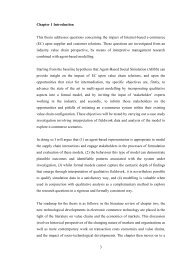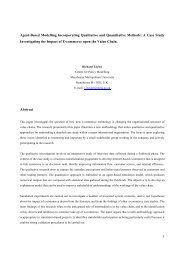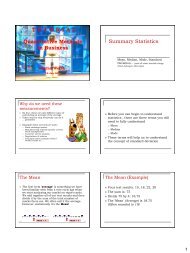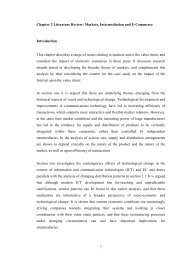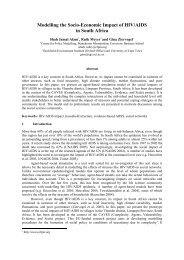characterising the envelope of sets of social simulation trajectories
characterising the envelope of sets of social simulation trajectories
characterising the envelope of sets of social simulation trajectories
Create successful ePaper yourself
Turn your PDF publications into a flip-book with our unique Google optimized e-Paper software.
specification (which for most 3 classes <strong>of</strong> program) is known to be impossible in general (Edmonds and Bryson2004). Instead we will have to be satisfied with differing inner and outer bounds for <strong>the</strong> <strong>envelope</strong>. Secondly, toreiterate that <strong>the</strong>re will be no pro<strong>of</strong> method that will guarantee to ei<strong>the</strong>r come up with a pro<strong>of</strong> <strong>of</strong> a specifiedstatement or that no such pro<strong>of</strong> is possible. Ra<strong>the</strong>r we will have to settle for incomplete methods – those thatmay come up with a pro<strong>of</strong> but may fail even when a pro<strong>of</strong> exists. Finally, <strong>the</strong>re is always <strong>the</strong> temptation to oversimplifymodels. The danger in this is that <strong>the</strong> complete chain <strong>of</strong> inference that can be used to reason about <strong>the</strong>target phenomena may be weakened, even though <strong>the</strong> inference within <strong>the</strong> model is streng<strong>the</strong>ned. As (Hesse1963) describes <strong>the</strong>re are (in <strong>the</strong> simplest version) three stages in using a model: (1) <strong>the</strong> interpretation <strong>of</strong> thatphenomena into <strong>the</strong> initial conditions on <strong>the</strong> model; (2) inference using <strong>the</strong> model from those conditions to <strong>the</strong>significant results; and (3) <strong>the</strong> interpretation <strong>of</strong> those results back to <strong>the</strong> target phenomena as predictions orexplanations. Simplifying a model may streng<strong>the</strong>n stage (2), but if this also involves making <strong>the</strong> model moreabstract (which it almost always does) this will weaken stages (1) and (3) and hence <strong>the</strong> whole chain. This is amajor problem with analytic models – <strong>the</strong> inference within <strong>the</strong> model is strong, giving closed-form solutions but,in <strong>the</strong> case <strong>of</strong> complex phenomena, this is <strong>of</strong>ten at <strong>the</strong> cost <strong>of</strong> introducing drastically unrealistic assumptions,resulting in a solvable abstract model which has lost its relevance to <strong>the</strong> target phenomena 4 .3 A structured approach to <strong>social</strong> <strong>simulation</strong>In this section I describe an architecture for such an approach that can help attack <strong>the</strong> problem <strong>of</strong> <strong>characterising</strong><strong>the</strong> <strong>envelope</strong> <strong>of</strong> <strong>trajectories</strong>. It is also compatible with <strong>the</strong> goals <strong>of</strong> <strong>the</strong> open comparison <strong>of</strong> <strong>sets</strong> <strong>of</strong> <strong>trajectories</strong> asdescribed in (Edmonds 2003); with facilitating <strong>the</strong> important distinction between motivated and pragmatic parts<strong>of</strong> a <strong>simulation</strong> set-up as described in (Edmonds 2005); as well as aiding in <strong>the</strong> checking and comparison <strong>of</strong>models (Hales, Rouchier et al. 2003).A model’s specification is separated into different parts, reflecting <strong>the</strong> different roles that each plays:A specification <strong>of</strong> <strong>the</strong> fixed structure <strong>of</strong> <strong>the</strong> model (<strong>the</strong> fixed structure or FS). These are akin to <strong>the</strong>declaration <strong>of</strong> variables in typed languages and are helpful because <strong>the</strong>y implicitly indicate <strong>the</strong> possiblevalues each can take. This might also include <strong>the</strong> structure <strong>of</strong> agents, within agents and <strong>the</strong> temporalstructure. The structure is usually imposed by <strong>the</strong> modeller based on how <strong>the</strong>y view <strong>the</strong> target phenomena,i.e. largely in <strong>the</strong> realm <strong>of</strong> a priori knowledge but informed by knowledge <strong>of</strong> <strong>the</strong> phenomena.Constraints on <strong>the</strong> model <strong>trajectories</strong> (<strong>the</strong> active constraints or AC). These are a set <strong>of</strong> active constraints onwhat is acceptable (on <strong>the</strong> basis <strong>of</strong> knowledge <strong>of</strong> <strong>the</strong> modelling target) in terms <strong>of</strong> solution <strong>trajectories</strong>. Ifone <strong>of</strong> <strong>the</strong>se constraints were violated this would indicate <strong>the</strong> trajectory was not one <strong>of</strong> those intended by <strong>the</strong>modeller. This might include <strong>the</strong> specification <strong>of</strong> acceptable value for parameters, or expressing structuralcertainties implicit in <strong>the</strong> modelling target (e.g. only one agent has <strong>the</strong> parcel).Logical relations between components <strong>of</strong> <strong>the</strong> model (<strong>the</strong> logical relations or LR). These indicate <strong>the</strong> fixedrelations between <strong>the</strong> parts <strong>of</strong> <strong>the</strong> model in deterministic ways (e.g. accounting rules, or <strong>the</strong> effects <strong>of</strong> anaction). These are largely derived from knowledge <strong>of</strong> <strong>the</strong> target system.A set <strong>of</strong> generative rules including non-deterministic branch points (<strong>the</strong> generative rules or GR). Thesegenerate <strong>the</strong> possibilities within <strong>the</strong> constraints, which would include points where random numbers/choicesare made (or where floating point operations are performed). These are <strong>of</strong>ten not representative, in that <strong>the</strong>ystand for parts <strong>of</strong> <strong>the</strong> target phenomena which are ei<strong>the</strong>r unknown or considered unimportant.Extra constraints to aid model solution (<strong>the</strong> extra constraints or EC). Often in constraint programming <strong>the</strong>addition <strong>of</strong> even redundant constraints (ones that <strong>the</strong> programmer knows will be respected anyway due to<strong>the</strong> o<strong>the</strong>r constraints) greatly aids <strong>the</strong> constraint satisfaction process by making <strong>the</strong> propagation <strong>of</strong>constraints easier. To check whe<strong>the</strong>r <strong>the</strong>se are, in fact, redundant one, can try <strong>the</strong> system without <strong>the</strong>constraints to see if <strong>the</strong> results change. There is no difference between EC and SC in implementation terms,however keeping <strong>the</strong>m separate aids model understanding and manipulation. Checking constraints including system checks and hypo<strong>the</strong>sised outer bounds for <strong>the</strong> <strong>envelope</strong> (<strong>the</strong> checkingconstraints or CC). These are constraints that, if violated, generate an error message and stop <strong>the</strong>computation. These could ei<strong>the</strong>r be checks against bugs in <strong>the</strong> model or hypo<strong>the</strong>ses <strong>of</strong> outer bounds that arebeing experimentally tested against generated <strong>simulation</strong> <strong>trajectories</strong>.These parts are conflated in most <strong>simulation</strong> work, so that it is <strong>of</strong>ten not made clear which parts arerepresentative and which are merely necessary for implementational reasons. Such a structure allows for <strong>the</strong>development <strong>of</strong> <strong>simulation</strong> models as follows (<strong>the</strong>se and <strong>the</strong> parts above will be illustrated in 4).3 “Most” here includes all those which use arithmetic, and thus almost every known <strong>social</strong> <strong>simulation</strong>.4 This is made explicit in some economic thought, for example (Hollis 1975) traces how neo-classical economics is notabout <strong>the</strong> <strong>social</strong> phenomena <strong>of</strong> exchange (how people actually trade) but how ideally rational actors might.


